By Jeffrey A. Rendall; Photos By Kevin Gaydosh
CAPE CHARLES, VA – It’s a writer’s worst nightmare, basically needing to tell the same story twice, yet trying to find ways to make it sound different. Many a lonely soul has retreated into the bottle or the realm of plagiarism when faced with such a dilemma, only to find that the ‘cure’ was worse than the ailment.
Thank God it’s not the same for golf course designers, as we discovered at the recently opened (Fall of 2005) Nicklaus Course at Bay Creek, on Virginia’s eastern shore. Here in this ‘remote’ part of the Old Dominion is found two of the finest golf courses in the Commonwealth, each inspired by a different legend of the game, and each possessing the stuff that makes up a memorable golf experience.
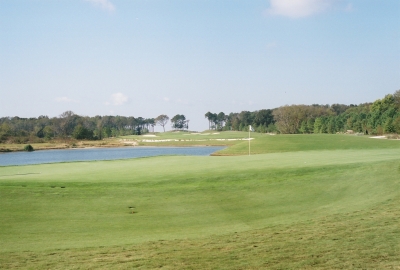 |
| Greenside at the par four 2nd (471 yards), you can glance across the pond towards the 3rd hole -- the gateway to the ocean. |
Bay Creek’s Palmer course unveiled five years ago to accolades of the highest order, proclaiming a new era of revitalization for this historic, yet somewhat forgotten section of the state, isolated from the ‘mainland’ by the Chesapeake Bay. You can reach Cape Charles from the Norfolk/Virginia Beach area via the 17.6 mile-long Chesapeake Bay Bridge-Tunnel, but that carries with it a hefty toll ($17 round-trip, if within 24 hours) – or you can drive south from points north on the eastern shore, which will provide a scenic, though lengthy drive.
In other words, there wasn’t a lot in this area to begin with. Bay Creek’s owner, Dick Foster, took a mighty big gamble in trying to build this difficult-to-reach stretch of earth into a golf destination – yet with Arnold Palmer’s, and now Jack Nicklaus’s help, he’s done just that.
And despite occupying virtually identical plots of land, each golf course offers its own distinctive look – hence alleviating the need to tell an identical tale (and avoiding this writer’s worst nightmare). Palmer and Nicklaus, ever competitive on the fairways during their playing careers, have taken that same sense of drive into their golf course designs. Here, side-by-side, they’ve both left their mark.
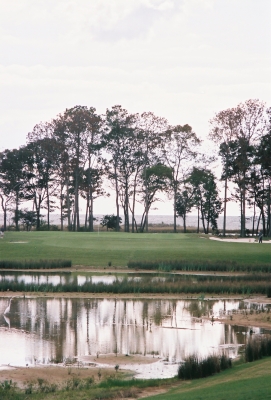 |
| Even obscured by a gloomy gray sky, there's a subtle beauty to the par three 12th hole. |
Dave Heatwole, Senior Design Associate at Nicklaus Course Designs (and Project Manager at Bay Creek), explains that their goal was to create something that would live in harmony with what was already there, yet also stand out: “With the Nicklaus Course, we wanted a unique golf course that would flow gracefully with the existing natural features of the land. We wanted it to be challenging from the back sets of tees, and playable from the middle and forward tees. And we wanted something that would compliment the Palmer Course, while also generating great vistas for the future residential development.”
At face value, you might think Heatwole was being nice by mentioning the Palmer effort so favorably in his opening remarks, but he stressed that this really was a joint endeavor between the two design firms, with each taking about half the land and adding their own personal touches: “Bay Creek was an interesting kind of ‘collaborative’ effort. The entire 36 holes were laid out together by Vickie Martz of Palmer Design and Bruce Borland of our firm. Dick Foster then determined which nine-hole loops each architect would design.”
He continues, “Because of the flat nature of the site, Jack didn’t make his first visit until we’d already started some tree clearing and bulk earthmoving. In fact, Mr. Nicklaus’s initial view of Bay Creek was from a helicopter as he arrived for his first site visit.”
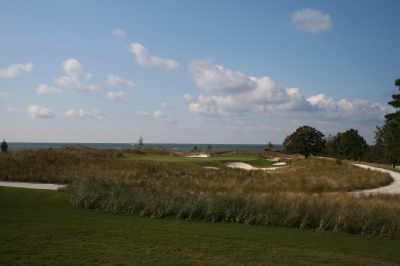 |
| Jack Nicklaus doesn't like the term 'signature hole,' but most would probably say the short par three 4th hole is the most memorable. |
For you golf historians, you’ll recall that Borland was killed along with Payne Stewart in October, 1999. It can be said that Bay Creek will serve as another piece of his worthy legacy.
As Heatwole indicated, to make things ‘fair,’ Foster gave each architect some land along the Chesapeake. The adjoining parcels of land for the Nicklaus and Palmer courses are so similar that they even crisscross at the clubhouse area.
Glancing a bit farther back, the land that Bay Creek now occupies has significant historical interest in and of itself. Condensing about 400 years of English settlement into a few sentences (taken from Director of Golf Tom Stevenson’s treatise on Bay Creek’s history) – the land that now makes up Bay Creek was first surveyed by Captain John Smith a year after Jamestown settlement was established in 1607. Friendly relations with the region’s Native American tribes encouraged settlement, eventually leading to the area’s consolidation into King’s Creek Plantation, which became one of Virginia’s most productive agricultural and fishing quarters during the Colonial period.
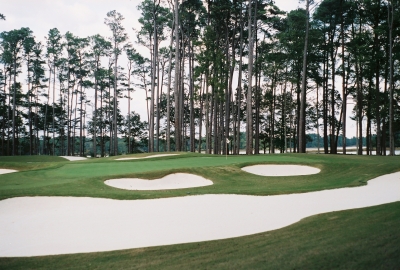 |
| Close to the green on the par five 16th hole. Like most holes, you'll see lots of sand, and a pretty tiny putting surface. |
In the ensuing centuries, Cape Charles continued to function primarily as an agrarian and fishing community – and because of its location, as a harbor and railroad hub for passengers heading north and south (who would be ferried across the Chesapeake). The Town of Cape Charles was established in 1884.
Moving ahead to more ‘modern’ history, Dick Foster acquired the Bay Creek property in September of 1996, intending on building a first-rate golf destination, but also a residential community and marina, amongst other things. Work began on the golf courses in 1998, and the rest, you could say, is ‘history,’ albeit a brief one.
There’s little doubt that the Bay Creek property was special from a heritage perspective, and certainly had its breathtaking views of the Chesapeake and Old Plantation Creek – but according to Heatwole, there still were challenges to overcome in adding golf to the site: “We realized right away that this was a rare and great piece of land to work with, but it was also difficult to take what was generally a very flat site and create unique golf holes – all the while maintaining a good relationship with the existing vegetation, and then establishing great views from the development areas onto the golf.”
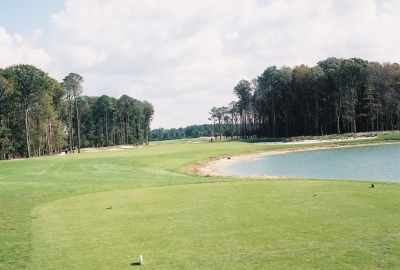 |
| The view from the tee of the par five 9th hole -- framed by trees, there's still lots of room out there to hit your tee ball. |
There were environmental considerations as well, since the design team had to maintain 100-foot setbacks from the creek and the bay. Pondering how much ‘creek’ and ‘bay’ there is on this course, that’s a fair amount of acreage that’s off the planning table from the beginning.
Heatwole said there was more to think about: “One of the largest tests was to tie three distinctly different landscapes (wooded lands, open fields and existing sand dunes) together to provide a seamless flow to the layout. We also needed to design a golf course that would handle the varying wind conditions encountered at Bay Creek. We considered not only how the wind would affect play, but also the exposure, location and shape of the bunkers – to prevent the sand from blowing out.”
We noticed, and Heatwole pointed out, that all the greens near the bay were tucked into the dunes to offer some degree of wind protection. That’s especially evident with the green of the par four 5th hole. At 459 yards, with a small green tucked into a sand dune, this is one of the more difficult links you’re going to play anywhere.
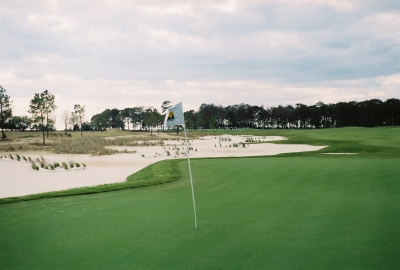 |
| Looking back from the green of the par four 13th hole. At 498 yards, it's the Nicklaus Course's longest par four -- probably the most difficult, too. |
Small greens in general are a characteristic of Bay Creek’s Nicklaus Course – it’s a discernible departure from its Palmer sibling, which boasts some really big putting surfaces. Heatwole said the smaller greens were put in to protect par. Like all Nicklaus courses, the Bay Creek version offers strong shot values and bold strategic features, which requires players to manage their game in order to score well.
There’s plenty of room to play the ball on most holes on the Nicklaus course, which helps compensate for the small putting surfaces. However, one thing you’ll notice in abundance is sand. Having seen a fair representation of Jack’s work, I know he likes waste areas… and Bay Creek may qualify as one of his ‘sandiest’ yet.
Stevenson says there are over 100 bunkers on the course – and with the size of those previously mentioned waste areas, it seems like there’s a lot more than that. Waste areas increase the playing areas on any golf course, and since they’re usually not classified a ‘hazard,’ they’re even somewhat player friendly. But it’s still better to find the turf.
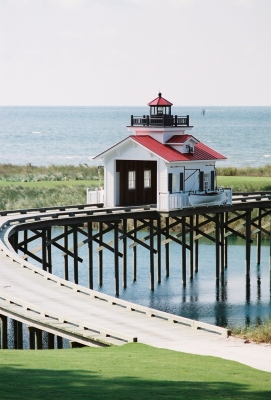 |
| The cart bridge on the par three 4th hole continues Bay Creek's nautical/historical theme. |
Ironically, despite resting on the banks of the mighty Chesapeake, Bay Creek’s sand isn’t ‘native’ to the area. Heatwole says they shipped in sand from Ohio because of its superior quality in terms of playing and maintenance properties. The fact that Jack Nicklaus is from Ohio – he ought to know where the best sand comes from.
Aside from the sand and turf, there’s water, though not so much as you might expect on a seaside golf course (at least when it comes to influencing play). And one thing at Bay Creek that you most likely wouldn’t be looking to see, unless you’ve played the Palmer Course (or the Signature at West Neck, also a Baymark Golf Property) – is landscaping.
Dick Foster’s not a golfer, but he’s certainly a lover of landscaping. Many golf courses have reputations for flowering flora, but Bay Creek is designed around it. Stevenson says there are hundreds of thousands of roses throughout Bay Creek resort, and it’s definitely something you’ll take with you when you leave.
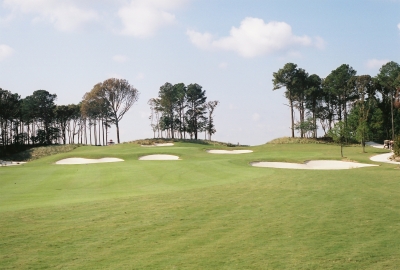 |
| The 557-yard, par five 3rd hole is Bay Creek's #1 handicap hole. It's very forgiving off the tee, but you'll see its challenge as you get closer to the flag. |
One bit of advice: since both courses may not be open on any given day, it’s best to call ahead to see which will be open. The Bay Creek folks rotate the courses to help preserve conditions on both, and the playing surfaces will match the colorful greenery in terms of quality.
If there was anything that was problematic about our visit to the Nicklaus Course, it was pace-of-play. Since we hit it on a day when the Palmer Course wasn’t operating, we experienced a good sized crowd with several significant waits on tee boxes. While we had no such troubles several years ago when we played the Palmer Course, it might be best to check ahead of time to make sure there isn’t a potential problem-in-the-making with a longer than normal round.
But on the whole, making the trip to Bay Creek – to play either of the courses – is well worth the effort. Foster has set the prices right, and the effort that’s gone into designing, building and maintaining the golf courses is hard to match anywhere in the Mid-Atlantic. If both courses are open on the day you plan to go there (and you’ve got the stamina), you definitely should consider playing both layouts in one visit.
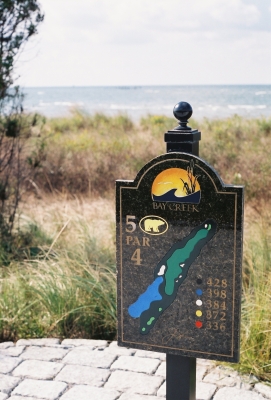 |
| Even the hole marker signs are classy at Bay Creek. |
To sum up, the Nicklaus course is a great compliment to the already fine golf product at Bay Creek. It’s different enough to keep it interesting, yet shares the same dedication to showcasing the natural beauty of the historic and scenic destination that is Virginia’s eastern shore.
And for this writer at least, it’s a relief to not have to tell the same story twice… even if it is a good one.
Where We Stayed
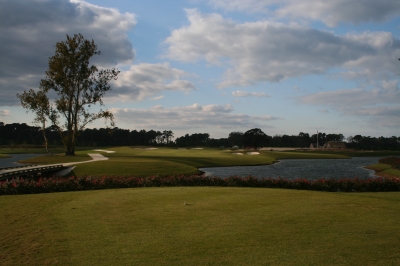 |
| No slouch for a closer on Bay Creek's par four 18th hole. One of the finest finishing holes in the region. |
Staying in Virginia Beach is always a treat, as there’s a number of nice hotels right along the waterfront. We chose the Courtyard by Marriott North, conveniently located on Atlantic Avenue, which provided access to all that Virginia Beach has to offer – much of it within walking distance.
Finding the Chesapeake Bay Bridge-Tunnel was a cinch – but it was also a bit of a drive out to Bay Creek. Keep that in mind when making your hotel/golf reservations.
For the non-golfing members of our party, they enjoyed the hotel’s proximity to the Virginia Marine Science Museum, and then took advantage of the multitude of restaurants located in the area.
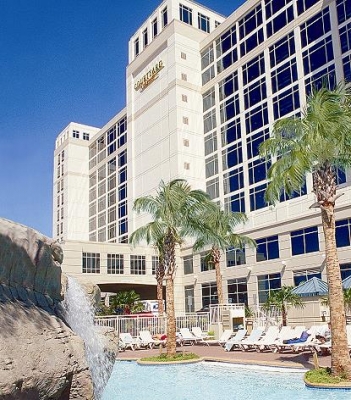 |
| The Courtyard by Marriott North in Virginia Beach. |
The hotel itself offered quite a few amenities, essential to your vacationing good time: a full-service restaurant, a tropical swimming pool on the beach with rock waterfalls, room service and complimentary valet parking. In its 160 rooms (including Suites/King/Double), you’ll find two dual phones with dataports; high speed internet access – perfect for you internet junkies; a 25” TV with pay-per-view movies and Nintendo; coffee maker, hair dryer, refrigerator, full size ironing board and USA Today delivery for each room; and guest laundry facilities. All rooms feature an oceanfront view with a balcony.
Fitness nuts will enjoy the fitness center, and kids of all ages will love the indoor pool, open year-round. Lastly, after a long day on the course, there’s a hot tub for the ultimate in relaxation.
We don’t generally endorse hotels at any particular destination, but we will say that the Courtyard by Marriott North made our stay particularly pleasant, and would certainly recommend it if you’re looking for comfortable accommodations along the waterfront.
Courtyard Marriot North
3737 Atlantic Ave.
Virginia Beach, Va
757/437-0098
Details:
Bay Creek Resort & Club
1 Clubhouse Way
Cape Charles, VA 23310
Phone: 757-331-8620
Website: http://www.baycreekresort.com
Designers: Arnold Palmer and Jack Nicklaus
Director of Club Operations; Tom Stevenson, PGA
General Manager, Mark Wesolek
Director of Golf: Joe Burbee, PGA
Head Professional: Zach Pfingst, PGA
Course Development Visionary: Dick Foster
Tees/Yardage/Slope/Rating
Nicklaus
Black 7417 146/75.9
Blue 6789 140/73.0
White 6456 138/71.4
Gold 6091 134/69.5
Red 5244 127/71.8 (Women)
Palmer
Black 7250 142/75.2
Blue 6832 137/73.2
White 6328 132/70.7
Gold 5687 120/68.2
Red 5195 127/71.5 (Women)
Rates:
Winter (December, January and February) - $30-$45
Off Season (November and March) - $40-$60
Season (April through October) - $55-$115
Discounts available for Juniors and Seniors. Rates include cart, taxes and Pro Link GPS.
Advance tee time reservations welcomed, please call the Golf Shop.
| Related Links | Comments on this article? | |
|
Maryland National Golf Club Hollow Creek Golf Club Rocky Gap Resort PB Dye Golf Club in Ijamsville Whiskey Creek Golf Club |
E-mail Jeff Rendall, Editor: jrendall@golftheunitedstates.com |











